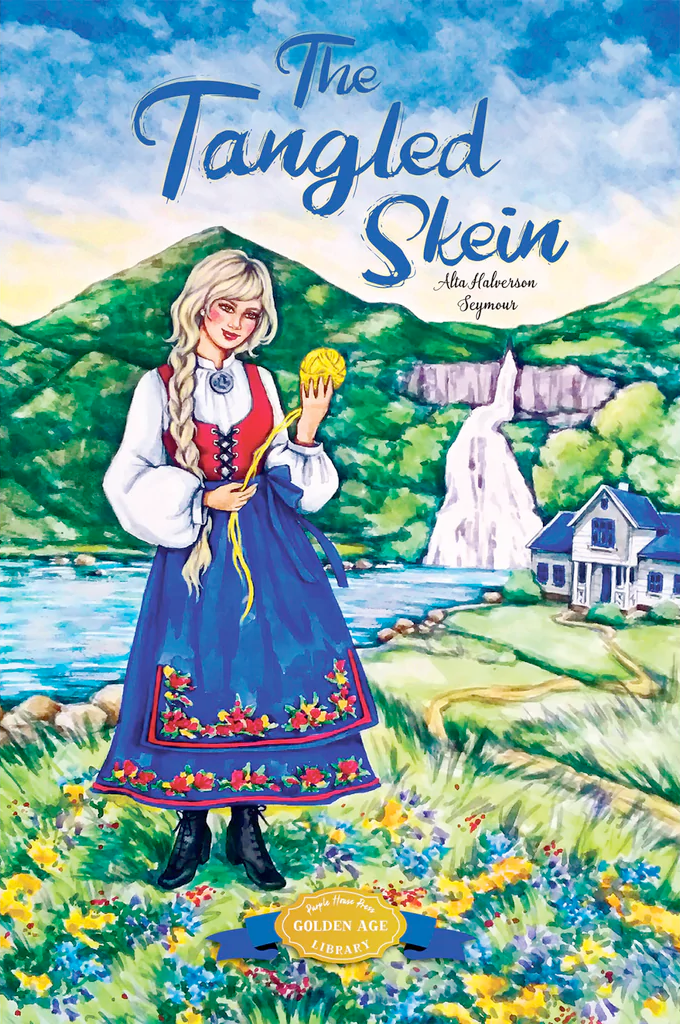The Tangled Skein by Alta Halverson Seymour is as wonderful as the Purple House Press cover is beautiful! Originally published in 1946, it was written on the heels of WWII, and captures the challenges of that very moment in Norway beautifully.

Most of my WWII history “education” has been gleaned from movies and books that are almost always from the perspective of the Allies. In recent years I have been reading Hilda van Stockum, and her stories of occupied Holland gave me a new perspective and fostered sympathy in me for the hell those people lived through. Seymour’s story is similar in that regard, but it is told from yet another new-to-me vantage point.
The Tangled Skein opens just after the war has ended, and is told from the perspective of the Norwegians and the Nazi collaborators they called Quislings. In particular, it follows the story of Solveig and her family, the Strands, who were thought to be Quislings. But, of course, this is a tangled skein, and it must be unraveled if the truth is going to be uncovered.
A child of the 80s and 90s, I went to high school in a time when history, 20th Century history in particular, was considered passé. I remember learning history in my small Catholic elementary and middle school, but by the time I got to the big public high school, history was being supplanted by “social studies,” which focused more on cultural things than on actual history streams. Consequently, I learned almost nothing about WWII in school. As a triple major in Philosophy, Religion, and English, at Hillsdale College, my studies of history were limited to pre-modern cycles and that which was relevant to my philosophy and religion focus. Therefore, almost everything I have learned about the world wars I have learned through personal study and homeschooling my own children.
One of the themes of this story is that of hunger. I have long loved 84 Charing Cross Road by Helene Hanff, and I re-read it every year, at least. I was shocked the first time I read it when I realized how hungry Europe was, for years after WWII. This spring I read Margot Benary Isbert’s The Ark and Rowan Farm and was shocked, again, to realize how devastated the German people were by the end of the war. Currently, I am reading William Shirer’s Landmark book, The Rise and Fall of Adolf Hitler. I now have a better understanding of how Hitler intentionally destroyed Germany’s resources at the end of the war as a punishment to them for failing to win the war.
In The Tangled Skein, we have yet another perspective on the hunger of starving war-torn nations. In Norway, where fish are abundant, boats were scarce. A nation built on fishing was brought to its knees by the German occupation. Fishing boats were commandeered by the Germans or used in the resistance and then sunk or captured. When the war ended and the Germans left, the Norwegian people were hungry and without many resources to build new boats.
This marvelous village story is written with elegant language, vibrant characters, fascinating twists and turns, and a happy ending. A sad topic is handled with much grace and, ultimately, resolves just right. We read this book aloud in our Morning Basket time over a few weeks. It was enjoyed and appreciated by my teens and my eleven-year-old.
A word about the Purple House Press reprint of The Tangled Skein. I noticed this book because of the cover. For six months, I saw this book on Jill’s website and lingered over the beauty of the cover. I didn’t order it during that time because I was overwhelmed with all of the books that I needed and was working on. This summer, however, I decided to buy it simply because I couldn’t “walk past it” again. And, what a treat it was! This new cover on this fresh reprint is the perfect invitation into this delightful and exciting story.
You can learn more about this book and Alta Seymour Halverson at Biblioguides.